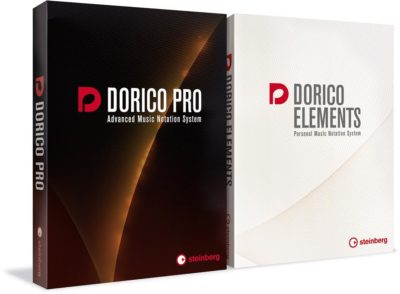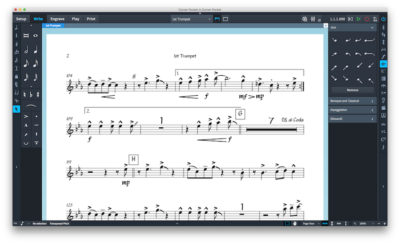New Software Review: Dorico 2 by Steinberg

Steinberg’s newest iteration of Dorico is an easy-to-use, yet robust and comprehensive solution for music notation.
For years, Avid’s Sibelius has been the industry standard for music notation software. However, over time, alternatives from companies like Presonus, Band In A Box, Steinberg and more have surfaced and begun to give Sibelius a run for its money.
Today, I’m excited to dive into Steinberg‘s newest iteration of their music notation software Dorico Pro, now on version 2. With plenty of new features to explore, we can see for ourselves if Dorico can compete with the plethora of modern scoring tools vying for your attention.
Features
Dorico 2 is available in two editions: Elements and Pro. Elements is a new and more affordable version of the software while Pro can be thought of as the “full” version. Although both have a very robust build, Pro features a wealth of additional tools, an expanded library of sounds, and deeper customization, whereas Elements offers more of an entry-level user experience. This review was conducted using Dorico Pro 2; you can learn more about the differences between the two versions here.
Dorico Elements is a great tool for students and performers who make their own charts; it allows for full ensemble scores and charts for up to 12 players. Although the sound bank is more limited than the Pro version, it still contains 1,500 sounds that will take up 2GB of storage. All this combined with the same automatic music layout of Dorico Pro 2 makes Elements a fantastic choice for those looking for an easy-to-navigate entryway to composition and arranging software.
Dorico Pro 2 offers deeper levels of customization, including the ability to pick custom page layouts, note spacing, accidentals, and noteheads. I didn’t find much need for these features, but it’s helpful to know you can get this detailed if needed.
Dorico 2 now includes the same video engine as seen in the latest versions of Cubase and Nuendo, allowing you to view thumbnails in Play mode and add markers that then appear in your score. There’s also a new Tempo Automation control in Play mode that allows you to line up markers with beats, which is useful for figuring out the tempo for a cue. For the media composer who relies heavily on music notation, it’s new features such as these that seem to make Dorico stand out among the competition.
One surprisingly cool feature is the new handwritten Petaluma font that mimics the look and feel of Real Books. (For those not familiar, Real Books are a kind of “required reading” for jazz musicians, and act as an encyclopedia of jazz standards and songs.) Personally, I don’t write too much jazz music, but this seems like a really useful feature when printing sheet music for jazz players who might feel more at home with this familiar font.
In Use
If you’re totally new to Dorico, or are just interested in getting the absolute most out of the software, Steinberg has created a number of in-depth and easy-to-follow YouTube tutorials to help guide you through your experience.
Among other cool scoring features, I love that when attaching a video to your project in Dorico, the software will read the video file from the original location and not have to make a copy of the entire file into a local folder. When working on films with other scoring software, I might end up using an additional 6GB+ of hard drive space just because of all the redundant video files. It’s design choices like this that seem to really show how in tune Steinberg is with the needs of the modern media composer.
My main fascination with Dorico has been what the company calls “cutting-edge artificial intelligence [that] automatically rewrites your notation, allowing you to spend more time composing and less time making corrections.”
While reviewing the software, I was asked to mock up and create sheet music for a solo cello performance on a network TV show. While I wouldn’t always recommend testing new software under a deadline, I decided to try using Dorico 2 for this project. I had already mocked up the audio using a Spitfire library in Logic, and once the network approved it, I exported the MIDI and imported it directly into Dorico. After selecting Violoncello in the instrument drop-down menu, the music immediately looked great. I spent about 15 minutes adding some bowing marks and dynamics information, and finished everything way ahead of schedule. The artificial intelligence in Dorico is truly outstanding, and as a composer, I plan on continuing to export MIDI from my main DAW directly to Dorico to make charts and notation for my musicians.
After this fantastic experience, it became clear that Dorico 2 can save you tons of time over the scope of an entire project, and provide you with the freedom to focus more on the actual composition of your music rather than the minutia of the scoring itself.
To Be Critical
Personally, I didn’t encounter any issues running Dorico 2 on a MacBook Pro, though I have heard that it can run smoother on Windows systems. I have noticed a substantial difference in performance running Steinberg’s Cubase software on Windows over Mac computers.
That said, nothing really stood out as being potentially problematic in Dorico 2. I find most scoring software to be either way too complex to navigate, or conversely very limited in features. Dorico seems to strike a great balance between user-friendly design and a comprehensive feature set—a combination that will be appreciated by all.![]()
Summing it Up
Dorico 2 definitely holds its own within the world of scoring software, and arguably may be one of the fastest and most comprehensive for making really professional audio demos as well. The ease of MIDI automation and the enhanced video engine also make Dorico 2 an incredible tool for film scoring, especially for those who typically deal with traditional notation. The AI integration for making the beat divisions and subdivisions will also save you time, and in turn will free up some bandwidth for you to write more music. Additionally, the clean visual layout of the notation will surely be appreciated by any musician who is reading from one of your scores.
In terms of pricing, owners of the original Dorico software can upgrade to Dorico Pro 2 for $99, which happens to be the same cost as Dorico Elements. Cross-grades from other notation software, including Sibelius and Finale, are available for almost 50% off the sticker price. If you’re brand new to the notation software game, you can purchase Dorico Pro 2 for $559.
I truly believe Steinberg’s Dorico 2 may be the best standalone notation software available, especially in terms of overall efficiency and ease of use. I highly encourage you to check it out—you won’t be disappointed
Please note: When you buy products through links on this page, we may earn an affiliate commission.







